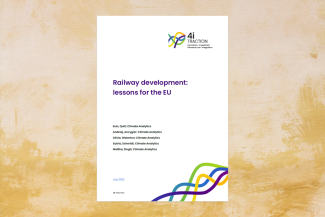
E Quill, A Ancygier, O Waterton, S Schmidt, M Singh (2023) Railways development: lessons for the EU. Climate Analytics; Berlin
Railway development: lessons for the EU
This paper analyses how EU railway policy for a low-carbon future can be enhanced, drawing insights from Japan and Switzerland.
As the EU’s second most polluting sector after electricity generation, transport will be key to achieving the bloc’s climate goals. Transport emissions increased by 57% between 1990 and 2021, indicating that a major policy U-turn is needed. A modal shift away from road and aviation towards railways, particularly for short and medium distances, will go a long way to getting the sector back on track. However, EU member states have failed to fully tap into railways’ potential, as reflected in financing and infrastructure investments which tend to favour road infrastructure over rail. The EU's existing policy framework provides funding and technical guidance for rail networks but falls short of enabling transformative change. Regulatory changes and substantial investments are necessary to enhance rail connectivity, reduce journey times, and enable trains to compete with cars and planes.
When looking to the future of European railways, lessons can be taken from Japan and Switzerland; two countries with some of the best functioning rail systems in the world. This report explores how both countries improved their rail systems and identifies valuable lessons that can be applied to the EU context. While there is no single blueprint for this transformation, understanding successful policy and financing mechanisms in other countries can allow European policymakers to apply proven examples to their national contexts.
The Japanese and Swiss case studies demonstrate the importance of combining government and private funding to build new infrastructure, open new lines, and maintain vital yet unprofitable connections. Japan’s reorganisation of the national rail scheme to vertically integrated but regionally distinct rail companies greatly improved punctuality and efficiency, with high customer satisfaction levels following. Looking elsewhere, Switzerland's financing scheme, akin to a ‘polluter pays’ principle, has generated enough revenue to fund a world-class rail system, making rail transport more appealing and supporting the shift from road to rail.
Drawing upon the selected cases, this report identifies key policy steps which can improve EU railway policy. Establishing a robust governance structure at the EU level is key to the success of any significant intervention. The European Railway Agency (ERA) operates in a mostly technical role, and its competencies and resources should be expanded to effectively facilitate the shift from road to rail. Additionally, sufficient funding for infrastructure expansion and seamless cross-border connections should be mobilised. By supporting decisive action in the railways sector, the EU can support the shift to low-carbon transport, work towards its climate goals, and empower a more connected and mobile citizenry.
This report is a spin-off from the report "What can the EU learn from non-EU countries on its path to climate neutrality?". A longer-form look at each of the case studies presented can be found in chapter 6.